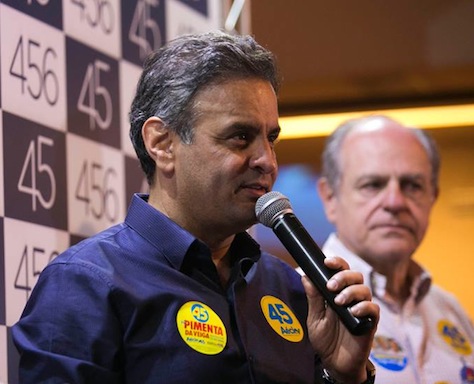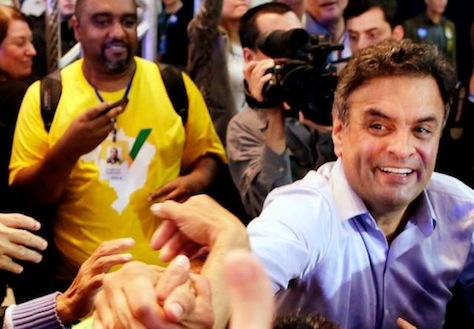A month and a half ago, when Brazil’s investor class proclaimed its doubts about the reelection of president Dilma Rousseff, no one stood to gain more than Aécio Neves.![]()
![]()
The grandson of a distinguished pro-democracy activist, Neves (pictured above) represents the next, post-lulista generation of Brazil’s center-right politics. Three decades younger than Brazil’s last conservative president, Fernando Henrique Cardoso, and more charismatic than former São Paulo governor and mayor José Serra, Neves brought to the race a strong pedigree and an accomplished record as an economic reformer as the two-term governor of the powerful, sprawling state of Minas Gerais.
That was before the airplane crash that killed former presidential candidate Eduardo Campos, which suddenly catapulted his running mate, the popular Marina Silva, into the presidential race.
Where Neves once had credible hopes of becoming Brazil’s next president, he now seems likelier to play a kingmaker role in what’s shaping up to be a fiercely contested runoff between Rousseff and Dilma.
* * * * *
RELATED: Why Marina Silva must now step up for the Brazilian left
* * * * *
Within days, Silva leapt to the lead in polls for the race to become Brazil’s next president. Though Rousseff has now recovered a first-round lead in many polls, Neves is still languishing in third place, far behind both Rousseff and Silva, a reverse from the summer, when Neves held a solid second-place position against the late Campos, who was leading a coalition anchored by the Partido Socialista Brasileiro (PSB, Brazilian Socialist Party) that, until recently, supported the Rousseff government.
Polls show that the October 26 runoff will be incredibly tight between the two women, and many officials within Neves’s party, the center-right Partido da Social Democracia Brasileira (PSDB, Brazilian Social Democracy Party), popularly known as the tucanos (‘toucans’) was already talking a month ago about how they’ll support Silva, a former environmental minister under Rousseff’s mentor, Luiz Inácio Lula da Silva, in the runoff. Armino Fraga, a former central bank president known for stabilizing the Brazilian real in the early 2000s, who returned to the fray to help elect Neves, is now being floated instead as a possible finance minister in a potential Silva administration. Fraga, for now, refuses to serve in any administration other than Neves’s.
A career defined by Minas Gerais
Despite his relative youth, Neves has been a fixture in Brazilian politics since the return of democracy in 1984.
His grandfather, Tancredo Neves (pictured above with his grandson), who served as a minister of justice in the final, elected government of Brazil’s longest-serving 20th century leader, Getúlio Vargas, served as governor of Minas Gerais between 1983 and 1984, and he was selected, by electoral college, as Brazil’s first post-dictatorship president in 1985. The elder Neves became ill and died, however, and his running mate, José Sarney, became president instead.
The younger Neves was elected in 1986 from Minas Gerais to the lower house of the Brazilian Congress, the Câmara dos Deputados (Chamber of Deputies), where he would serve four terms, ascending to the presidency of the Chamber of Deputies in 2001.
Despite an ill-fated attempt to win the mayorship of Belo Horizonte, the capital of Minas Gerais, in 1992, Neves was elected in a first-round landslide in Minas Gerais’s gubernatorial election in 2002.
Despite the fact that Minas Gerais is the second-most populous within Brazil, and an engine of economic growth, Neves inherited a state in poor fiscal health. As governor, he introduced waste-reduction measures to balance the state’s budget, eliminated jobs and significant waste within the state’s government.
As the former Economist correspondent Michael Reid writes in his splendid book, released in June, Brazil: The Troubled Rise of a Global Power, Neves’s tenure is viewed as a nearly unqualified success:
When [Neves] was elected as governor in 2002, the state was nearly bankrupt. He appointed a team of public management specialists under Antônio Anastasia, an academic, who boosted tax revenues, streamlined procurement and cut costs in what they called a ‘management shock.’ After two terms of Neves, minieros elected Anastasia, who is stolidly uncharismatic, to succeed him. Businessmen rate Minas Brazil’s best-run state, according to one survey; the state spends over 8 per cent of its budget on public investment; poverty has fallen faster than in the country as a whole, and Minas has the best-performing schools.
Along the way, Neves became the darling of Brazil’s business class. By nearly all accounts, not just Reid’s, Neves ran a tight government that restored the state’s treasury while devoting attention to reducing violent crime and lifting its poorest residents out of poverty, aided in no small part by Bolsa Familia, the cash handout and social welfare program that Lula da Silva instituted last decade.
Rousseff and her allies within the governing Partido dos Trabalhadores (PT, Workers’ Party), however, have tried — with some success — to paint Neves as a wealthy, out-of-touch elitist and an insider with ties to Brazil’s traditional conservative ruling class. That’s probably unfair, but Neves could have done a better job of defining himself over the past four years since leaving the Minas Gerais governor’s office.
Neves returned to federal politics in 2010 with his election to the upper house of the Brazilian Congress, the Senado (Senate), representing Minas Gerais.
Neves’s lifelong background as a native of Minas Gerais would have been a huge advantage in a runoff against Rousseff, who won the state against Serra in the 2010 presidential election by a margin of 58.45% to 41.55% (and Lula da Silva won it by an even wider margin in 2002 and 2006).
It’s nearly impossible to underestimate the role of Minas Gerais in Brazilian politics. It has a population of 19.9 million, second only to São Paulo state, and a GDP that’s the third-largest in Brazil. In the first Brazilian republic between 1889 and 1930, Minas Gerais was the ‘leite‘ in the ‘café com leite‘ (coffee with milk) politics whereby officials from the coffee-rich state of São Paulo alternated in power with officials from the dairy-rich state of Minas Gerais. That’s a balance that still rings true today — Neves’s running mate, Aloysio Nunes, is a is a senator, former deputy and former vice governor of São Paulo.
The state’s name, which translates to ‘General Mines,’ underlies the importance of the region as a source of gold and other minerals during Portuguese colonial rule beginning in the 17th century.
Eclipsed by Silva, eyes on 2018?
At age 54, Neves might easily have another shot at the Brazilian presidency if he narrowly misses in 2014. Elected to the Senate four years ago, he’s only halfway through his eight-year term, and no one would begrudge him a loss against Rousseff, an incumbent president with Lula da Silva’s considerably powerful support, and a star candidate like Marina Silva, dramatically thrust into the race weeks before the election after Campos’s death, with the potential to become Brazil’s first African-Brazilian president, as the daughter of rubber plantation workers in the Amazon who was illiterate until age 16.
Neves isn’t exactly campaigning like a man who expects to survive the first round on October 5, because he’s concentrated his efforts mostly in and around his home state of Minas Gerais, where a recent IBOPE poll shows Neves narrowly trailing Rousseff by 33% to 29% in the first-round vote. Winning his home state, even if he finishes in third place nationally, would be at least a minor moral victory.
Another reason might be that the PSDB is in danger of losing power, with its candidate, Pimenta da Veiga, trailing by 20 points among mineiros, in both first-round and runoff surveys, to the PT’s Fernando Pimentel, the former mayor of Belo Horizonte and since 2011, the minister of development and industry. Anastasia, the star technocrat of the Neves administration, is now running for the Brazilian Senate instead.
Furthermore, Neves has been tougher in his criticism of Rousseff, who’s faced a new scandal involving bribery and corruption within Brazil’s state-owned oil company, Petrobras, over the past two weeks, than Silva, who he might ultimately endorse in a runoff.
Nevertheless, if Silva (or Rousseff, in a second term) cannot turn Brazil’s economy around in the next four years, Neves would be well placed to launch a triumphant comeback in 2018, when it will have been fully 16 years since the last tucano president left office in Brazil, and voters might well be ready to hand the reins to Neves.
Neves is also supported by a coalition of eight additional parties, including the Democratas (Democrats), a more conservative party that is the successor to the Aliança Renovadora Nacional (ARENA, National Renewal Alliance), the party that controlled Brazil during the 1964-85 military dictatorship.




Ok, can we stop spreading this nonsense about how the PSDB and Aecio in particular are great managers?
During his term as governor, primarily in order to avoid paying pension obligations and other labor costs, Aecio started to hire government workers en mass through a shady, non-public hiring process. That process has since been invalidated by the State Supreme Court and now the Federal Supreme Court as being blatantly illegal and now almost 100 thousand state employees (that’s about 10% of the state’s employees), most of them teachers, will have to be let go. This is probably the single reason why both Dilma and Pimentel are leading in Minas Gerais and Aecio is scared to lose his own state. But on top of that is the fact that the state of Minas perennially fails to fulfill the Constitutionally mandated minimum investment in health and education.
Furthermore, just to bury this notion once and for all, Aecio and the PSDB are always touted as the people who are ready to tackle the problem of the ‘bloated public bureaucracy,’ whose critics say is really just a play for the PT to maintain its hold on power through favors. But Minas, a state with 10% of the country’s population has almost 80% the number of public offices indicated by the governor as the federal government has by the president. 80%!